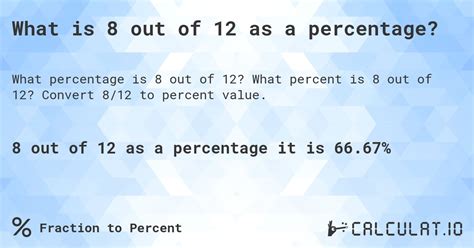What Is 8 Out Of 12 As A Percentage
Kalali
Apr 02, 2025 · 4 min read

Table of Contents
What is 8 out of 12 as a Percentage? A Comprehensive Guide
Determining percentages is a fundamental skill with broad applications across various fields, from finance and statistics to everyday life. Understanding how to calculate percentages allows for easier interpretation of data, comparison of values, and informed decision-making. This comprehensive guide delves into the calculation of "8 out of 12 as a percentage," explaining the process step-by-step and exploring various related concepts.
Understanding Percentages
A percentage is a fraction or ratio expressed as a number out of 100. The symbol "%" represents "percent" or "per hundred." Essentially, a percentage indicates the proportional relationship of a part to a whole, where the whole is always considered 100%.
Calculating 8 out of 12 as a Percentage: The Step-by-Step Method
To find out what 8 out of 12 represents as a percentage, we'll follow a simple three-step process:
Step 1: Formulate the Fraction
First, express the given values as a fraction. "8 out of 12" translates to the fraction 8/12.
Step 2: Convert the Fraction to a Decimal
Next, convert the fraction to a decimal by dividing the numerator (8) by the denominator (12):
8 ÷ 12 = 0.666666...
This decimal is a recurring decimal, meaning it continues infinitely. For practical purposes, we'll usually round to a certain number of decimal places.
Step 3: Convert the Decimal to a Percentage
Finally, convert the decimal to a percentage by multiplying the decimal by 100 and adding the "%" symbol:
0.666666... × 100 ≈ 66.67%
Therefore, 8 out of 12 is approximately 66.67%.
Simplifying the Fraction: A More Efficient Approach
Before diving into the decimal conversion, simplifying the fraction can make the calculation easier. Both 8 and 12 are divisible by 4:
8/12 = (8 ÷ 4) / (12 ÷ 4) = 2/3
Now, we convert the simplified fraction 2/3 to a decimal:
2 ÷ 3 ≈ 0.666666...
Multiplying by 100 gives us the same approximate percentage:
0.666666... × 100 ≈ 66.67%
Simplifying the fraction first reduces the complexity of the division and improves accuracy when working with non-recurring decimals.
Practical Applications of Percentage Calculations
The ability to calculate percentages has widespread applicability in various real-world scenarios:
- Finance: Calculating interest rates, discounts, profits, and losses. Understanding percentage changes in stock prices or investment returns is crucial for financial planning.
- Statistics: Analyzing data, interpreting survey results, and representing proportions within a larger dataset.
- Retail: Calculating discounts and sales tax, understanding profit margins, and comparing prices.
- Education: Determining grades and scores, assessing student performance, and representing progress.
- Science: Representing experimental results, analyzing data, and expressing concentrations.
- Everyday Life: Calculating tips, splitting bills, and understanding proportions in recipes.
Beyond the Basics: Advanced Percentage Calculations
While calculating "8 out of 12 as a percentage" is a relatively straightforward process, understanding more complex percentage calculations can be beneficial:
- Percentage Increase/Decrease: Calculating the percentage change between two values. For example, if a price increases from $10 to $12, the percentage increase is calculated as: [(12-10)/10] x 100% = 20%.
- Percentage of a Number: Finding a percentage of a given number. For example, finding 25% of 80 is (25/100) x 80 = 20.
- Finding the Original Value: Determining the original value when given a percentage and the resulting value. For example, if 75% of a number is 60, the original number is 60/(75/100) = 80.
- Compound Interest: Calculating interest earned on both the principal and accumulated interest. This is a crucial concept in finance and investments.
Mastering Percentage Calculations: Tips and Tricks
- Practice Regularly: The more you practice, the more comfortable you'll become with calculating percentages.
- Utilize Calculators: Calculators can significantly speed up the calculation process, especially for complex problems. Many calculators have a dedicated percentage function.
- Understand the Concepts: Don't just memorize formulas; understand the underlying concepts of fractions, decimals, and ratios.
- Check Your Work: Always double-check your calculations to ensure accuracy.
- Simplify Fractions: Simplifying fractions before conversion makes the calculation easier and less prone to errors.
- Rounding: Be consistent with rounding decimal values to avoid discrepancies in your final results.
Conclusion: The Significance of Percentage Calculations
The ability to calculate percentages is a vital skill with applications in numerous fields. Understanding how to calculate percentages accurately and efficiently is crucial for interpreting data, making informed decisions, and solving practical problems. Mastering these skills provides a solid foundation for further mathematical understanding and enhances problem-solving abilities in various contexts. From simple calculations like determining "8 out of 12 as a percentage" to more complex financial and statistical analyses, the ability to work with percentages is an invaluable asset. By practicing regularly and understanding the underlying concepts, you can confidently tackle any percentage-related challenge.
Latest Posts
Latest Posts
-
64 Oz Is How Many Cups
Apr 03, 2025
-
Are Humans Cold Blooded Or Hot Blooded
Apr 03, 2025
-
400 Degrees Fahrenheit Is How Many Degrees Celsius
Apr 03, 2025
-
How Many Seconds In 2 Minutes
Apr 03, 2025
-
What Is 170 Cm In Inches
Apr 03, 2025
Related Post
Thank you for visiting our website which covers about What Is 8 Out Of 12 As A Percentage . We hope the information provided has been useful to you. Feel free to contact us if you have any questions or need further assistance. See you next time and don't miss to bookmark.
